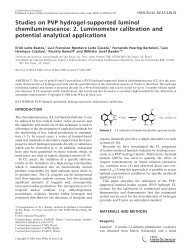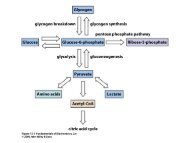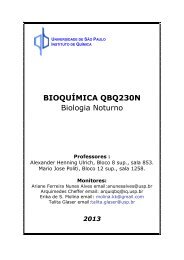Bettina MalnicNEUROCIÊNCIA MOLECULAROrganização molecular do sistema olfatório emmamíferosO sistema olfatório <strong>de</strong> mamíferos é capaz <strong>de</strong>discriminar milhares <strong>de</strong> odores. Uma famíliamultigênica que codifica para aproximadamente milreceptores olfatórios (ORs) diferentes expressos nosneurônios olfatórios foi i<strong>de</strong>ntificada. Estes receptorespertencem à superfamília <strong>de</strong> receptores acoplados àproteína G (GPCRs) e apresentam 7 domíniostransmembrana.Preten<strong>de</strong>mos caracterizar proteínas que interagemcom os ORs para se compreen<strong>de</strong>r os mecanismosmoleculares envolvidos no sorteamento dosreceptores, assim como <strong>de</strong> transdução do sinalmediado por estes receptores.Utilizamos também ferramentas <strong>de</strong> bioinformáticapara varrer os bancos <strong>de</strong> dados <strong>de</strong> sequênciasgenômicas <strong>de</strong> camundongos e humanos paraprocurar genes candidatos que sejam expressosespecificamente no cérebro. Usaremos técnicas <strong>de</strong>biologia molecular para analisar o padrão <strong>de</strong>expressão <strong>de</strong>stes genes <strong>de</strong>ntro do cérebro.SummaryMolecular organization of the olfactory system inmammals.The olfactory system is able to discriminate anenormous amount of odorants with a variety ofchemical structures. The first step of discriminationoccurs when odors bind to odorant receptors (ORs)expressed by olfactory neurons in the olfactory epithelium.There are about 1000 different OR genes inmammals. The ORs belong to the G protein coupledreceptors super family, and have 7 transmembranedomains. We aim to i<strong>de</strong>ntify proteins expressed inthe olfactory neurons, which interact with ORs, inor<strong>de</strong>r to gain information about the molecularmechanisms responsible for the functional expressionof these receptors.We are also using bioinformatics tools to browsethe mouse and human genome databases for candidategenes, which would be expressed only in thebrain. Then we will use molecular biology methodsto check the pattern of expression of these geneswithin the brain.PublicaçõesSam, M.; Vora, S.; Malnic, B.; Ma, W.; Novotny, M.V. and Buck, L. (2001).Odorants may arouse instinctive behaviours. Nature 412: 142.<strong>Instituto</strong> <strong>de</strong> Química - Pesquisa 2001 - <strong>2002</strong> 18 Departamento Departamento <strong>de</strong> Química <strong>de</strong> FundamentalBioquímica
Bianca ZingalesBIOLOGIA MOLECULAR DETRYPANOSOMA CRUZITrypanosoma cruzi é o agente causador da Doença<strong>de</strong> Chagas que afeta cerca <strong>de</strong> 16 milhões <strong>de</strong> pessoasnas Américas. A Doença apresenta três formas clínicasprincipais: in<strong>de</strong>terminada, cardíaca e digestiva. Porsua vez, as populações do parasita isoladas <strong>de</strong>diferentes hospe<strong>de</strong>iros apresentam gran<strong>de</strong>diversida<strong>de</strong> genética, verificada utilizando-sediferentes marcadores moleculares. No passado,nosso grupo <strong>de</strong>finiu um ensaio <strong>de</strong> PCR dirigido parauma região do gene <strong>de</strong> RNA ribossômico que permitedividir as populações do parasita em dois gruposprincipais: T. cruzi I e T. cruzi II. Observamos que T.cruzi I predomina no ciclo silvestre da transmissão,ao passo que T. cruzi II é encontrado majoritariamenteem pacientes chagásicos (ciclo doméstico). Nomomento, estamos utilizando a tecnologia <strong>de</strong>microarranjos <strong>de</strong> DNA (Projeto CAGE) para análisesgenômicas comparativas entre cepas <strong>de</strong> T. cruzi e parai<strong>de</strong>ntificar genes diferencialmente expressos empopulações do parasita isoladas <strong>de</strong> pacientes comdiferentes manifestações clínicas da Doença <strong>de</strong>Chagas. Os marcadores moleculares serão úteis parao prognóstico da manifestação clínica que o pacienteirá <strong>de</strong>senvolver, permitindo intervenções a<strong>de</strong>quadas.Publicações:SummaryOur laboratory has ma<strong>de</strong> important contributionson the epi<strong>de</strong>miology of Trypanosoma cruzi, the causativeagent of Chagas disease, which affects 16 millionpeople in Latin America. Among others, thesecontributions are related to the <strong>de</strong>finition of molecularmarkers, which indicate the division of the taxonT. cruzi into two major phylogenetic lineages (T. cruziI and T. cruzi II). These lineages have different epi<strong>de</strong>miologicalcharacteristics. Presently, we are employingthe microarray DNA technology for comparativegenomic analyses of T. cruzi strains and to i<strong>de</strong>ntifygenes differentially expressed in T. cruzi populationsisolated from patients with different presentationsof Chagas disease (in<strong>de</strong>terminate, cardiac and digestiveforms).Mendonça, M. B. A., Nehme, N. S., Santos, S. S., Cupolillo, E., Vargas,N., Junqueira, A., Naiff, R. D., Barrett, T. V., Coura, J. R., Zingales, B. &Fernan<strong>de</strong>s, O. (<strong>2002</strong>). Parasitology 124, 177-184.Briones, M., Sanson, G., Kawashita, S., Amino, R., Brunstein, A. & Zingales,B. (<strong>2002</strong>) Mathematical and Computational Biology. Mondaini, R. editor.University of Brazil, R.J. 39-68.Ramirez, L.E., Lages-Silva, E., Alvarenga-Franco, F., Vargas, N., Fernan<strong>de</strong>s,O. & Zingales, B. (<strong>2002</strong>). Acta Tropica (no prelo).Stolf, B.S., Souto, R.P., Pedroso, A. & Zingales, B. (<strong>2002</strong>). Molecular andBiochemical Parasitology (no prelo).Umezawa, E. S., Bastos, S. F., Coura, J. R., Levin M. J., Gonzalez, A.,Rangel-Aldao, R., Zingales, B., Luquetti, A. O. & Franco Da Silveira, J.(<strong>2002</strong>). Transfusion (aceito para publicação).Control of Chagas Disease - Second Report of the WHO Expert Committee- WHO Technical Report Series 905 - World Health Organization <strong>2002</strong>,109 páginas.Departamento <strong>de</strong> Química Bioquímica Fundamental19<strong>Instituto</strong> <strong>de</strong> Química - Pesquisa 2001 - <strong>2002</strong>



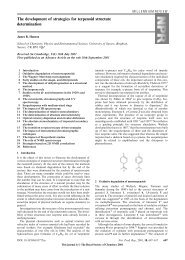
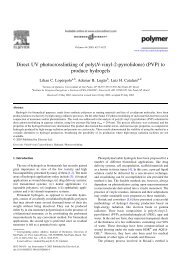
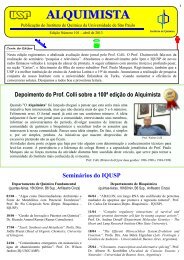
![PE]+ + N. Fragmentação por clivagem sigma](https://img.yumpu.com/50134385/1/180x260/pe-n-fragmentaaao-por-clivagem-sigma.jpg?quality=85)
